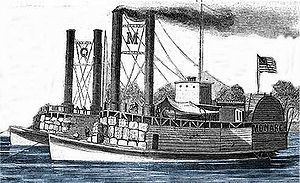Ordered unknown Acquired April 1862 Out of service July 1865 Length 55 m Displacement 368,300 kg | Laid down 1853 at Fulton, Ohio Commissioned 1862 Fate scrapped July 1865 Weight 412.5 tons | |
 | ||
USS Monarch was a side paddle wheel ram in the United States Army. Monarch was built as a towboat at Fulton, Ohio, in 1853. She was converted to a ram in 1862 for service in the Ellet Ram Fleet under Lt. Col. Charles Ellet, Jr. operating on the Mississippi River in the American Civil War in conjunction with the Western Flotilla.
Contents
Battle of Memphis
Monarch was purchased at Pittsburgh in April 1862 and commissioned there, Capt. R. W. Sanford in command.
After fitting out at New Albany, Monarch began active duty with the Ram Fleet. Steaming downriver in May, she scouted Fort Pillow in June and joined USS Benton, USS Louisville, USS Carondelet, USS St. Louis, USS Cairo and her sister ship, USS Queen of the West, in the Battle of Memphis 6 June. Engaging the Confederate River Defense Fleet, the rams destroyed seven of the southern ships, wiping out the Defense Fleet as an effective naval force. Monarch rammed CSS Colonel Lovell and General Beauregard. The Union forces took Memphis 6 June, clearing the upper Mississippi of southern forts and naval craft. On 26 June, Monarch and Lancaster pursued General Earl Van Dorn down the Mississippi and up the Yazoo River, the Confederates burning the ship below Yazoo City to prevent her capture.
Battle of Vicksburg
Beginning in June, Monarch operated against Vicksburg, Mississippi. Monarch and five other ships departed Helena, Arkansas, 16 August on an Army-Navy expedition up to Yazoo River with troops landing at various points along the shore and destroying batteries on the river. Union ships captured CSS Fairplay above Vicksburg 27 August; Monarch then cruised the Yazoo with General Bragg to prevent Confederate use of steamer Paul Jones and to hinder communications with Vicksburg. Later that year, Monarch swept torpedoes in the Yazoo.
Later service
Monarch joined 11 other ships in the expedition to capture Fort Hindman 4 January 1863, a point that David Dixon Porter noted as “a tough nut to crack.” Joining efforts with William Sherman’s troops 9 January, the Union ships shared in the capture of Fort Hindman 11 January. In February, Monarch steamed up the Yazoo to Greenville to relieve Commander Prichett, controlling guerilla activity. In April, she joined USS Lioness, USS T. D. Horner, and USS Fulton in supporting Colonel Ellet’s marine brigade in the Tennessee.
With the fall of Vicksburg, in July, and the collapse of Confederate naval forces on the western rivers, the ram's mission was accomplished. She was dropped from the naval list in 1864, but remained in reserve, ready for recall to active service, until going to Mound City, Illinois for dismantling in July 1865.
